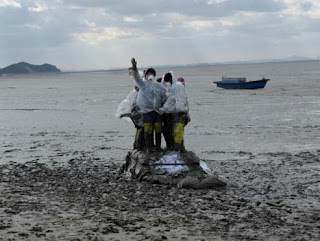 |
| Video Still from Lindi Arbi's Last One Standing |
In the context of this colloquium, I introduce Last One Standing to reflect on the status of real dirt in a glib technocracy – the kind of dirt so dirty that it resists being sampled and streamlined into the synthetic. How does technology cope with excessive materiality, I ask, and what happens to the dirt on our hands when its matter is mediated and dematerialised? In Arbi’s video, allusions to real dirt predominate. The terrain is muddy, the tethered sculpture is muddy, even the palette seems a dull, muddy grey. Ironically, however, the performance was recorded at high resolution; thus the scene may be muddy but the picture is crystal clear…
In response to this paradox, I argue that technology’s aversion to dirt is amply in evidence, as is its tendency to sanitise. At the same time, I suggest that the real dirty-work of Last One Standing lies not in the visuals but in the sound (or, more accurately, in their disjunction). For the clarity of what we see is distinctly at odds with the deafening, distorted crackle that we hear: a ‘bad’ recording of the gusting wind which drowns out almost everything else. In effect, the soundtrack captures the wind not as a sound but as a presence – as a series of waves which assault the recording equipment and then, in turn, assault our ears. Being a register of impact, this ‘dirty’ sound ruptures the sanitising screen of the synthetic: it reaches us materially (albeit invisibly), carrying real clout.

No comments:
Post a Comment